Projection screens. The main designs, types of canvas and coatings, the rules for their selection.
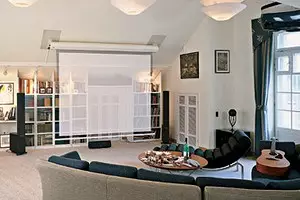
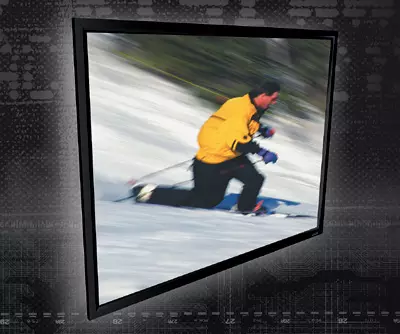
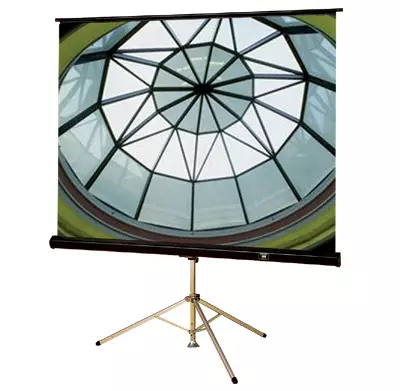
Portable screen on tripod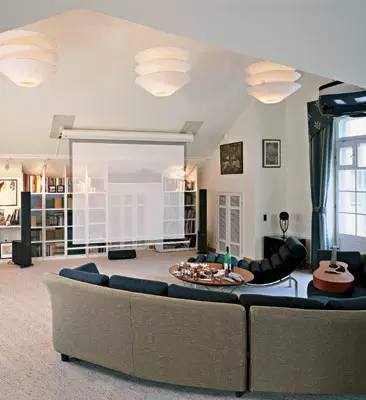
Photo E.Lichina
With one click on the Living room button turns into a home theater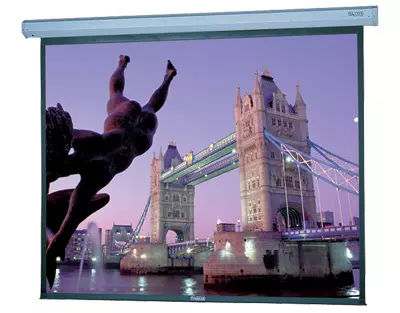
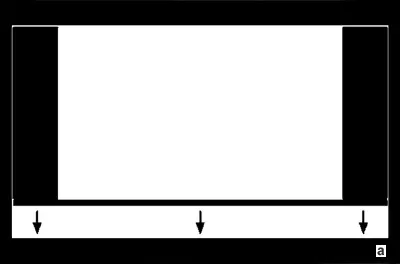
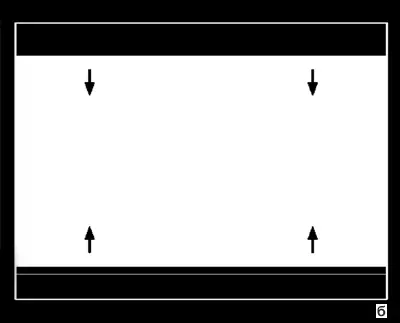
A-masking curtains are located on the right and left, the height of the screen is constant;
B-curtains are located on top and bottom, screen width is constant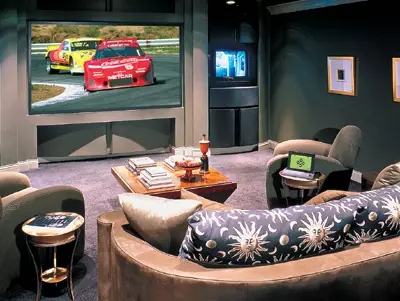
The home theaters often use screens with the ratio of the sides of 16: 9 (it is in such a format that films on DVD are recorded)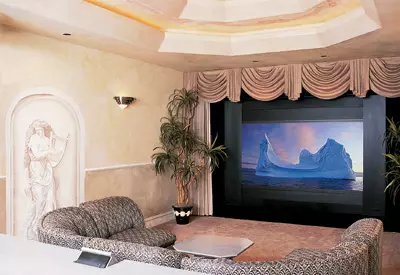
Screen with masking stripes
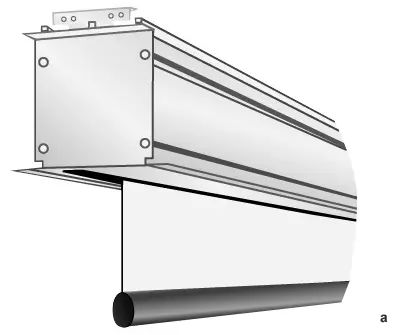
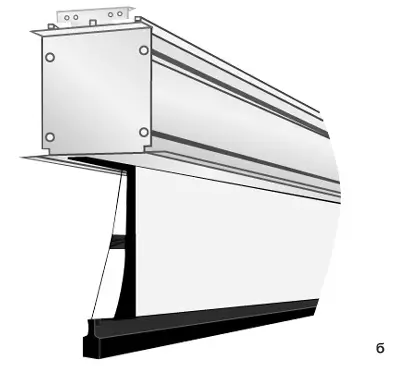
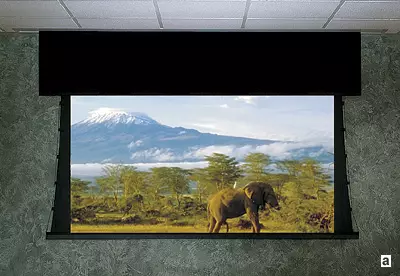
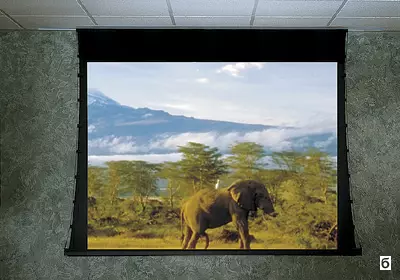
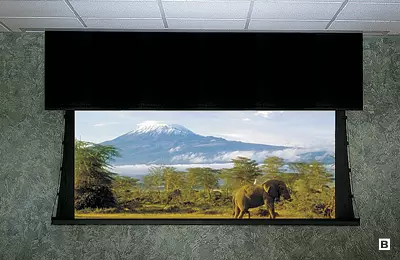
1.85: 1 WIDE SCREEN (A); 1.33: 1 (b); and 2,35: 1 Cinema Scope (B). Therefore, the screens equipped with a curtain system, much universal than their "neform-tirown" fellow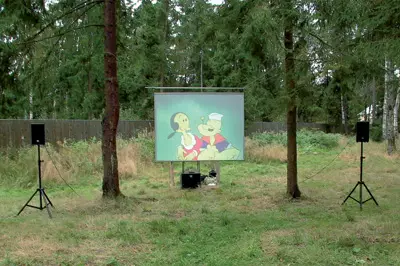
Reversion shields: the image is bright enough to use them in daylight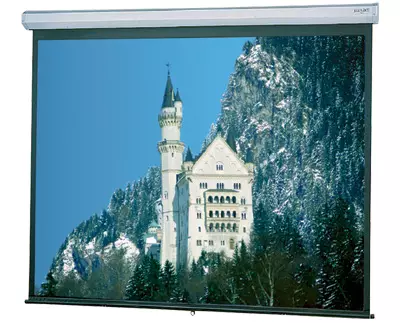
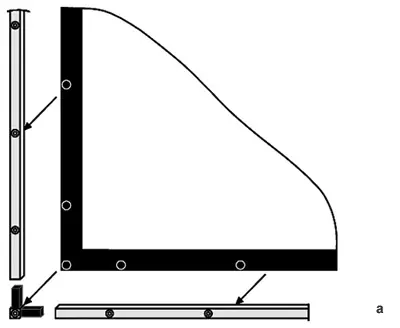
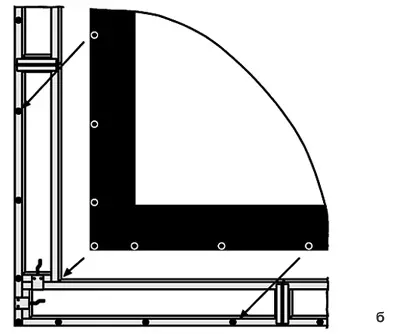
A-standard;
b-strengthened design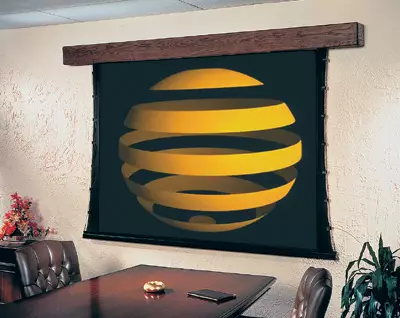
Vinyl canvas are easy to learn on stretch roses located on its sides. The Artisan screen has a body of a wood array
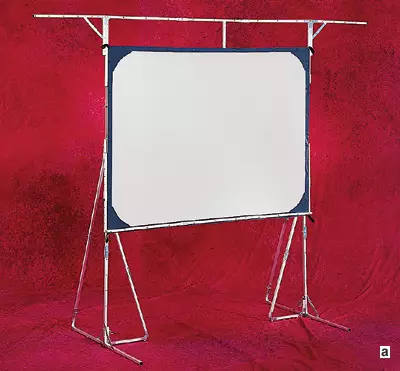
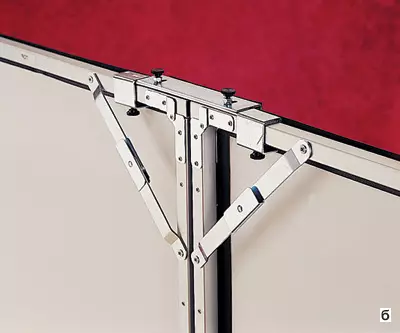
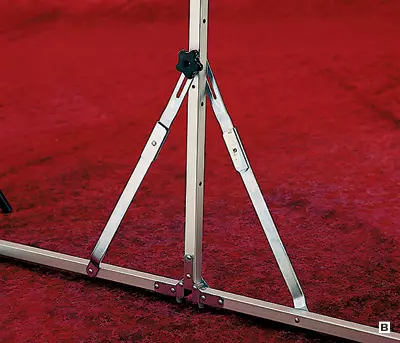
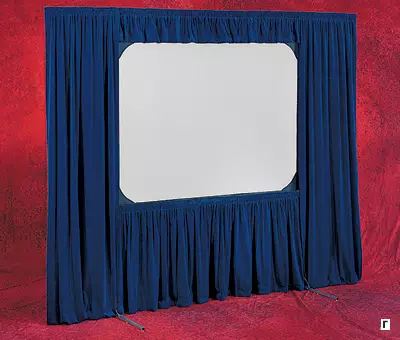
A-screen assembly;
B-frame made of aluminum profile;
The tilt of the legs is adjustable to remove distortion of the picture;
M-screen can be drained with a set of curtain Dress Up Kit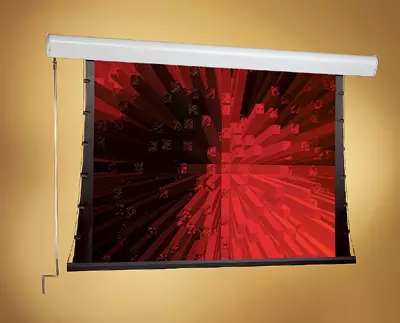
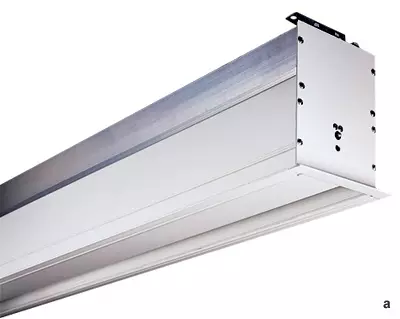
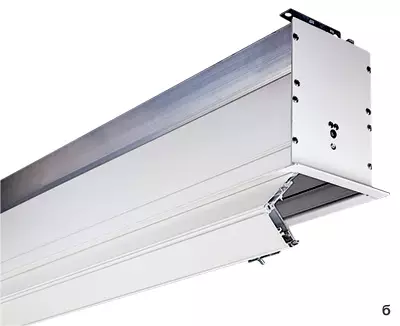
The screens for video projectors according to the design are much more complicated than the notorious "white sheets" with which they are voluntarily or involuntarily associated. It is not surprising that when choosing such a screen, home theaters are unexpectedly for themselves to face a number of problems.
The projection screens, as neither regrettable, still remain the most underestimated part of the home theater equipment, and they most often buy "on the residual principle." Meanwhile, the influence of this component of the system on the quality of the final image is very large. The poorly selected screen is able to spoil the impression of an arbitrarily good projector. In turn, the high-quality screen to some extent "smoothes" the shortcomings of a mediocre picture. We will try to tell us about the main designs and types of projection screens and the rules of their selection.
Window into the world of dreams
Blights . The main purpose of the screen of any cinema is displayed a picture playing with the help of projection equipment (cinema or video projector). The picture occurs on the web-most important and most expensive screen details. It must be homogeneous in color (not necessarily white, there are gray-coated screens), not to have visible flaws, stains and other defects, which in the same way spoil the image, as, say, scratches on the surface of the television lens. We will tell you more about the types of cloths below.Frame . Another important element of the screenshot, on which the canvas is attached. It can be either tough (most often metal, less often wooden) frame, used in stationary models, or a rolled system consisting of a casing, from where the rolled canvas comes from and the mechanism of its tension.
Rolled and stretch screens . Wall and portable models can be either rolled (the web after viewing is folded), or tensioning. The stretch screen is fixed in the aluminum (sometimes wooden) frame and either completely closes it (its mount is made by the buttons), or is located inside its contour (fastened, respectively, lacing). The stretch model can be equipped with a stationary mounting system to the wall. In this case, the wall screen of constant tension is obtained. The location of a similar model on the racks gives a mobile solution.
Tension system . Depending on the type of web, various tension mechanisms are used. A textile base is used on a textile basis, which is attached to the lower edge of the cloth. The patter structures of the mass of the strip, together with the mass of the screen itself, it is enough so that its surface is quite flat. Winnile models to achieve a flatness need to create additional side tension. This is usually done using a hinge tension system. It consists of two cables skipped through the loops located on the sides of the canvas. The cables are attached from above to the casing, and the weighting plank is suspended from below. Her weight and creates an effort, stretching the cloth to the sides.
Also, an electric motor, a remote control system, a device that allows you to manage the projection screen through the projector switch, and the stand (for portable modifications) can be included in the motorized models.
Method of fastening . The screens for home theaters are divided by the method of fastening on stationary and retractable rolled. In addition, they differ in the size of the canvas and the material from which it is executed. Depending on the installation method, the screens are wall, ceiling, wall-ceiling and outdoor. Installation capabilities depend on the mounting design. The ceiling model can only be attached to the ceiling, and wall-ceiling and to the ceiling, and to the wall. Knapolny can include all the designs that are installed on the floor. Moreover, the name reflects only the way of installation, it does not have a relationship to the properties of the device itself.
Gabarits. . As for the size of the canvas, there is a huge variety of sizes: from small models with a diagonal of 55-60 (for example, Vscreen 4040, Draper) to huge screens with a diagonal of 240-250. If you go to the usual metric system, then, say, the Rolleramic 450600cm model (Draper) is a cloth diagonal will be a 7.5m-quite acceptable value for the "sighup" cinema. The greatest popularity in the design of home theaters (that is, when placing projectors in the rooms with an area of 20-25m2), medium-sized screens (with a diagonal 2-3m) are used.
Formats . Screens differ from each other and according to the format ratio of the length of the vertical and horizontal sides. The most common formats - with a ratio of 4: 3, 16: 9 and 1: 1. Format 4: 3 (or 1.33: 1) is used where using the video projector to view ordinary TV channels, VHS video tapes, and use the projector-screen system as a source of the image for a personal computer or a game console. Format 16: 9 (1.78: 1) It is used to demonstrate most of the films recorded on DVD, as well as high-definition television gear (HDTV) and some satellite channels. It can be said that de facto format 16: 9 is a "cinematic", and precisely such screens (and video projectors) are homemade cinemas. Bnowly close to "geometry" Format 1.85: 1 (the so-called WideScreen).
When choosing a screen with a wall-mounted or floor mounting, it is necessary to remember that these devices can be sufficiently massive weighing in several tens of kilograms (and at the same time it is necessary to take into account the additional load that occurs when removing the roller screens canvas). Therefore, if you are planning the walls of the walls with plasterboard panels, in the fields of the attachment it is necessary to pre-install mortgage parts for the installation of the screen. Aesley You want to use the ceiling mount, keep in mind that such models should be installed using metal anchors (no plastic dowels!).
Significantly easier to mount the Access Series Screens (Draper). The lifting canvas, fixed on the shaft, is installed in the housing using special latches. Due to this, the hull itself can be fixed on the ceiling already at an early stage of finishing work, and in the future its design will be easy to "drown" into a plasterboard panel. This option eliminates the random damage of the web during construction work, and also simplifies its choice: canvas can be purchased separately, based on the type of projector.
Secrets of "High Matters"
Between themselves, the projection screens differ not only on the overall dimensions of the screen canvas, but also by the material from which their reflective surface and the substrate are made. Most often, the canvas are divided:
by type of base - vinyl on a tissue basis;
by type of coating material - on matte and special;
By type of projection, for direct and reverse projection (the so-called translucent-specific type of screen coatings, we will describe in more detail below).
Screens on a tissue basis are convenient because this material provides an absolutely flat surface. Large canvases can have almost imperceptible horizontal seams. The vinyl surface requires uniform tension, so vinyl screens, as a rule, a little (by 10-20%) are more expensive.
Gain . The quage properties of screen coatings include the so-called gain factor, contrast and the viewing angle of the resulting image. The gain is called the number indicating how many times the brightness of the beam reflected from the specific screen differs from the brightness of the beam reflected from the reference surface, the gain for which is adopted equal to 1 (the surface of the magnesium carbonate; in practice, a matte white plane is used as a reference Vinyl with fiberglass substrate).
Due to the special texture, the screens with a high (1.5-2.5) gain is capable of focusing the light falling on them from the projector in a specific direction, as much as the reflector does in the pocket lantern. Since the brightness of any source depends on the direction under which we look at it, a bright image from the screens with a high gain will be seen only by those viewers that are located in the direction of the spread of light reflected from the screen or near it. Therefore, in addition to the gain, the quality of the screen is also evaluated by the value of a comfortable viewing angle (on average it is equal to 30-40). Please note that for the screens with a high gain than the more audience places are shifted away from the projector's axis, the worse the picture will be visible. For the screens, the gain of 1 or less, the brightness of the picture will not depend on the location of the audience.
Types of coatings . A classic surface is considered a matte white (Matte White), which provides a uniform distribution of brightness throughout the plane and the gain coefficient equal to 1. This is in a sense of the industry industrial standard: all manufacturers of Matte White canvas have the same physical properties. The remaining coatings are special and are characterized by increasing (and in some cases a decrease in the amplification of the gain and an increase in the angle of a comfortable review. For the most reflecting models, this angle is approximately 30. Modern technologies allow you to obtain screens with an amplification coefficient 2.5 along the axis of the projection. Such, for example, the coatings M2500 (Draper, USA), Highpower (DA-Lite). Screens with the gain slightly more or less 1 provide high contrast (the ability to accurately reproduce halftone, light and dark sections of the picture).
Most manufacturers produce screens line with all types of coatings. The characteristics of the same type of surfaces in different manufacturers are practically no different, although they can be called differently. Some surfaces are shown in our table.
Manufacturers . The manufacture of projection screens in the world is engaged in relatively few companies, most of which are located in the United States (Da-Lite, Draper, Stewart, Vutec). EUROSCREEN (Italy), Medium (Germany), Reversa (United Kingdom), Projecta (Netherlands) are presented from European manufacturers in the Russian market.
Price . The cost of the projection screen depends on the type of coating and size of the canvas, as well as on the presence of a motorized drive and other structural elements. It must be said that the high-quality screen is a pleasure quite expensive and can cost from several hundred to several thousand dollars. As practice shows, ideally the screen cost should be approximately 30% of the cost of the video projector. Moreover, it is better to rebuild and buy a screen more expensive, because these devices are cheaper over time to a much lesser extent than projectors. The cheapest models of screens can be found for sale for $ 50-100.
The wider format, the movie is more interesting
Large American filmmakers (Panavision, 20th Century Fox) and individual director enthusiasts have long been led and continue to develop their image formats, in which the picture acquires greater expressiveness. The beginning was laid in 1952. The appearance of Cinerama format, in which the image has developed on the screen from the projections from three synchronously operating film installers. At the same time, the aspect ratio of the frame was 2.59: 1, that is, the picture was 1.4 times panoramic than the image in the usual 16: 9 format. K1975g. Such formats have already numbered at least a dozen (for example, Cinemascope, SuperScope, Vistavision IT.). Some of them were safely rushed into the summer, leaving us in memory of themselves two to three films, and some, such as Panavision with the aspect ratio of the frame of 2.35: 1, are widely used and so on. Among the well-known widescreen films "BenAn-Gur" (Ultra Panavision 70, 1: 2.76), Lawrence Arabian (Super Panavision 70, 1: 2,20), "War and Peace" ("Soviet" format SOVSCOPE, 1: 2.35), "Star Wars" (Panavision) and many others.
All to choose!
Selection of the screen for home theater is not easy task. It boils down to the definition of the size of the web, its type and location relative to the projector.At first, they decide with the location of the projector in the room, find a place for its installation (desktop or ceiling) - about this it was about the article "Sydi and see!" Our magazine. Then make the size of the screen sizes, based on the projection distance (detection to the canvas) of this video projector. To simplify this procedure, manufacturing manufacturers of projection equipment, such as Mitsubishi, Panasonic, Epson (all-Japan), offer on their sites program to calculate screen sizes.
Definition of the distance to the viewer . It should be remembered that for a comfortable viewing, the screen sizes must be proportional to the distance from the canvas to the audience. At the same time, according to specialists of a number of firms, the screen width should not exceed 1/2 distance to the first row of spectators, but should not be less than 1/6 distances to the last row of spectators. As for height, it should be at least 1/8 distances to the last row of spectators. Steewart specialists recommend another method. In their opinion, to determine the height of the panel, you need to divide the distance from it to the spectator chair by 3.3. The resulting value and will be a height. Ashirina Screen can be found on the basis of its parties (4: 3, 16: 9).
Format choice . 16: 9 format is used for films, and 4: 3- to view television programs. If a device is required for all occasions, it is better to choose models with retractable curtains that change the aspect ratio of the on-screen field, configuring it to a cinema or television option. Such, for example, 3Varivision (Projecta), Luxus Screenwall and Luxus Model A Electriscreen (Stewart), Dual Mask (EUROSCREEN). Applying a curtain is not a whim of the aesthetes from the cinema and not tribute to fashion. The fact is that a person subjectively evaluates the brightness and contrast of the image compared to the surrounding canvas surface. Screens with curtains eliminate ugly gray borders, due to which the frame loses entertainment. Depending on the design, the curtains can be mounted above the web (so-called kashets) and sides. Screens with side curtains are used with projectors that give the image 16: 9, and with the upper curtain, with the projectors 4: 3.
Stretching or roller? Wall stretch models, in contrast to roll, are characterized by an absolutely flat surface that provides a higher quality image. However, in this case, the owners will have to put up with their constant presence. Therefore, screens are usually mounted in rooms specifically designed for film premises. The rolled model can be located in a regular living room.
Choosing a type of coating . The type of screen coating is selected, based on the geometry of the visual hall and the number of spaces for viewing (the review sector is taken into account), the lighting conditions (darkening, natural or artificial light, the possible presence of lateral illumination), the requirements for brightness and contrast of the image (whether the brightness is enough Increase contrast), operating conditions (probability of surface pollution by fingerprints, dust IT.D.), type of projection (direct or reverse), the possibility of setting the dynamics of the central channel of the acoustic system behind the screen.
We have already said that the matte screens are universal and have a maximum viewing angle (this allows you to carry out a film preview before a fairly wide audience). Also, the matte surfaces smooth the defects of the picture obtained from inexpensive video projectors. But on high-quality screens with a high (order 2.5) coefficient of enhancing the disadvantages of the image of budget projectors will be more noticeable. In addition, similar screens reduce the viewing angle, which limits the number of convenient seats for the audience. But these canvases reflect the parasitic side illumination back to the source, visually improve the detail, increase the contrast of the image.
Most often, the high gain screens are used either in conditions of incomplete darkening of the hall, or in a set with projectors with a low power of the light stream. For example, the M2500 coating (DRAPER) is not recommended to be used in a pair with projectors with a light flow of more than 1000 ANSI LM. Invoice, low gain coating GrayHawk (Stewart), High Contrast S (Projecta), High Contrast Matte White (Da-Lite) can be used with projectors with medium and high brightness of the light flux.
Acoustics . Modern models allow the central loudspeaker directly behind the on-screen web. It is very comfortable for viewers: speech and sound support are not from below or from above, but directly from the "Event Center". To implement such a possibility, the web is perforated (the so-called acoustic transparent coating is obtained), and the number of holes can reach up to 350000 per 1m2 (Stewart). The more their quantity and less size, the more smooth looks the surface of the screen and fewer distortions occurs on the displayed picture with strong sound.
It is only necessary to remember that the loudspeakers cannot be put too close to the canvas, otherwise it will be (together with the image) in the most dramatic moments to squeeze. In addition, the micropores screen although the sound passes, but still partially absorbs (high-frequency part of the spectrum). Therefore, with a similar installation, it is necessary to rebuild sound accordingly.
On the dark side of the screen . If the features of the room allow you, then the video projector is sometimes installed not in front of the screen, but behind it. This uses translucent screens with a special translucent acrylic web.
The reverse projection agitation is a lot of advantages: there is practically noise from the projector, its appearance does not violate the harmony of the interior, none of the audience will not affect the silhouette on the screen. Such systems can be installed in wet rooms (for example, the sides of the pool), without fearing that the video projector will deteriorate. Yes, and on your performance, translucent screens look quite impressive. Thus, the gain coefficient near the New Wide Angle Screen (DNP, Japan) cannon is 3.5, and the High Gain White (Reversa) cannon is 6.8. True, such models are fairly expensive: depending on the diagonal of the canvas, several thousand dollars can cost and even more.
Valid dreams from translucent acrylic screens, four-layer Extra Drop (Euroscreen) is impenetrable even for bright light, since an opaque black substrate is located on the reverse side of the cloth. The screen with such a coating can be positioned, for example, above the window opening, in the deployed form, it will also serve as a shading room with a curtain.
CTQ
Modern screens are quite unpretentious in everyday life: almost all of them are equipped with washing canvases, resistant to fire and mold formation. This greatly simplifies the care of them. Matte screens can be wiped with a soft sponge with soap or other detergents, non-aggressive to vinyl. You can not clean only products Glass Beaded: There is a danger to damage the beads applied to their surface.
Screens are intended for indoor use (indoor), so it is necessary to observe the temperature regime of their operation (from 10 to 35C). All manufacturers strongly recommend installing them in well ventilated rooms. Dirt, dust and tobacco smoke adversely affect the condition of the canvas.
The screens of constant tension need more thorough care. After opening, they are not removed into the protective case, and therefore, much stronger than other similar products are at risk of random damage.
Much attention should be paid to protecting screens from mechanical impacts that can damage the surface. Automatic models with an electric drive require the execution of operating norms for electrical appliances (humidity, temperature IT.D.). Under all the rules of operation, the screens are able to serve for many years to serve their masters in the "world of dreams".
Types of coatings of projection screens for home cinemas
| Type of coating | Manufacturer | Description | Gain | Viewing angle, * |
|---|---|---|---|---|
| AT1200. | Draper | Acoustic transparent (perforated) surface | 1.0 | There is no data |
| Eclipse II. | Reversa. | Playing acrylic screen. The thickness of the canvas is 3mm. The screen can be used in the daylight without resorting to the dim room | five | 45. |
| FireHawk. | Stewart. | The canvas is designed specifically for DLP projectors. Increases the depth of black and total color saturation | 1,35 | 24. |
| Glass Beaded (GB) | Da-Lite, Draper | Beaded splashes on a matte-white tissue basis. Special coating with a narrow-controlled flow of image reflection along the projection axis. Excellent color reproduction with a small stride of clarity. Coating is resistant to fire and mold formation. No cleaning detergent | 2.5 | twenty |
| Grayhawk. | Stewart. | Gray canvas. Increases black levels, details of shades of gray and total color saturation. Used with LCD, DLP and D-ILA projectors | 0.95 | 40. |
| High Contrast. Matte White | Da-Lite. | Vinyl matte surface on a tissue basis. Increases contrast image | 1,1 | 45. |
| High Contrast S. | Projecta. | Vinyl coating. Designed for use in home theaters in moderately lit rooms. The gray surface of the surface provides better transmission of dark colors, clear and contrasting reproduction of image details. | one | 45. |
| High Gain White | Reversa. | Acrylic screen for reverse projection systems. The thickness of the canvas is 3mm. The screen can be used in the daylight without resorting to the dim room | 6.8. | 38. |
| Matte White (MW) | Da-Lite, Projecta | Universal coating, sometimes called diffuse matte. Vinyl matte-white surface on a textile basis with high color distribution uniformity. Suitable for all spring-loaded screens | one | fifty |
| Pearlescent. | Da-Lite. | Very smooth pearl vinyl coating. Has high reflective ability and brightness without loss of resolution pictures | 1.5 | 35. |
| Video Spectra. | Da-Lite. | Pearl surface designed to demonstrate video and images from LCD projectors in cases where a large viewing angle and high quality pictures are required | 1.5 | 35. |
| * - The viewing angle is specified, in which the amplification coefficient decreases by 50% |
The editors thanks the company "Business Vector International", "Mouth-Engineering", "Russian Game", CTC Capital, Delight 2000 for helping in the preparation of material.
